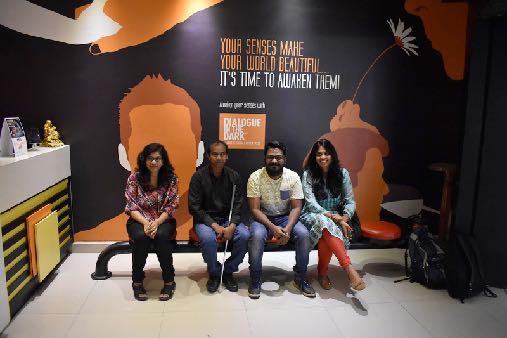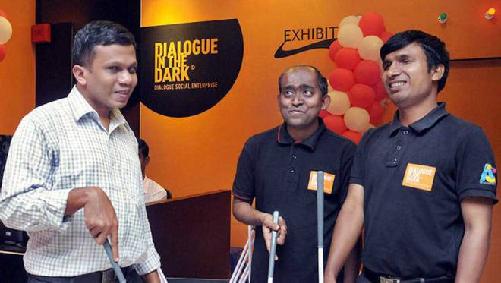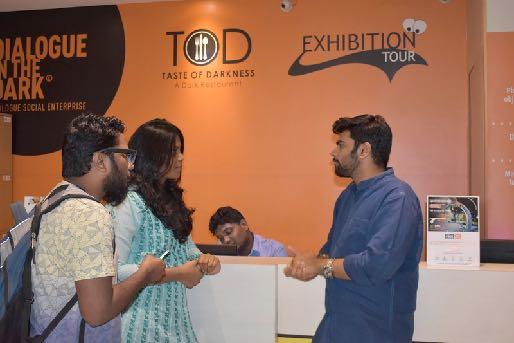Human-centered design
Design Kit
Human-Centered Design

Team Name: Designers of Hyderabad
Design challenge
Create employment opportunities for the differently abled
Sudeshna Mahata
Pradhan Thandra
Snigdha Guntuka
Hriday Y
Shayam Jesalpura
Plan your research
People to learn from
Experts to speak to
In-context immersion locations
Analogous inspiration locations
Final Summary
Human-centered design

People to learn from
We started exploring areas where we met people with both physical and mental disabilities.
Learnings from the Jobseekers


• Friendly work environment (empathetic)
• Specialized training
• Education qualification
• Career counselling, because they don’t know who to approach

• Work should be of interest and harness their abilities
Learnings from the Employers
• Job efficiency should be the same as an abled person
• Educational requirement (job/profession based)
• Where to source the employees from?
• Need exposure of the abilities of a physically challenged person.
Learnings from Research
Human-centered design

Learn from experts
Dr. Amal Kumar Mahata


(Ophthalmology specialisation)
Additional Chief Health Director
South Central Railway Hospital
• Consider the various levels of disabilities
• About disability certification
• An initial list for profession suggestions
Bhavesh Bhatia
CEO of Sunrise/Aroma Candles
Employed only visually impaired people to run the factory.
• Disability not a limitation
• Awareness with respect to professional trainings and job prospects
• Support from NGO’s and Government
Rosheena Ismail

Manager- Monitoring & Communication
ACE ( Awareness- Care -Empowerment) foundation


• Special training centres catering to different disabilities
• Interface between special training centres and industries.
Learnings from Research
Human-centered design

Learn from immersive experience
Dialogue in the Dark Experience 1: Dialogue in the Dark

Dining experience at the restaurant : Waiters are visually impaired
Dialogue in the Dark offers an insight into the world of the blind with a role reversal. The blind are the sighted and we are the blind. We witnessed a surprising yet unique dining experience. When we enter the restaurant, our entire entourage was guided by Mr.Rajesh – a very happy , confident and humorous person. Our entire three course meal was served to us with absolutely no glitch. Initially, it took a while for us to get accustomed to the atmosphere but after a while we realised that dark is not scary.
There was a heightened sense of sound and touch. We interacted with Mr.Rajesh and learned about his life. His job and the trainings provided has motivated him to pursue higher education as well. DID offers multiple posts depending on the skillset of each individual. He is now able to support himself and his family and dreams of advancing his career to the management level.
Learnings from Research
Human-centered design

Learn from immersive experience
Lifestyle Shopping Experience at Lifestyle: Hearing and Speech impaired cashiers

Lifestyle – a huge clothing store in India dedicates about 4% of its entire staff to hearing and speech impaired people. Generally, they are employed as the cashiers or the folders. The maximum career stage that can be achieved is a cashier.
The prime reason for such an approach is lack of awareness of the actual efficiency levels that a special need person can achieve when provided with the right kind of training and motivation. All the special needs employees wear a BADGE that gives away their disability for the customers to understand. During the SALE time , they are withdrawn from cashier duties since they believe that they will unable to address queries efficiently due to high influx of customers during that time.

Learnings from Research
Human-centered design

Seek Analogous Inspiration Locations
Our Objectives
To make the experience authentic and meaningful.
To create an experience that brings out wonder and awe.
To create a personalised experience
Our inspiration of reference environments
Hospitality expert who can tell how to deal with various personalities
A product designer.
A local small business shop owner
The party clowns and entertainers (who make the kids happy)
Amusement park managers/workers
Learnings from Research
Human-centered design

Our post-it wall
Insights, How might we and Ideas

Human-centered design
Insights
Theme: Awareness
• Basic awareness of the capabilities of these individuals. An understanding that anything that is dreamed is possible to achieve- in particular the parents and the teachers first.
• Awareness in the organisations regarding providing opportunities
• Need for empathy not sympathy.
• A basic social education on accommodating them.
• Simple talks and discussions on socialising must be encouraged.
How might we create awareness among the general public about the different abilities of these special people ?

Insights, How might we and Ideas
Human-centered design
Insights
Theme: Work Efficiency
• They are better abled for the right sectors . Determining and mapping is the need
• After the right amount of training the efficiency is on par or above with the general community
How might we create an efficient system of mapping the needs of the corporate system with the skill set of the differently abled and also connect special needs training centres to the companies that are open to hiring differently-abled ?

Insights, How might we and Ideas
Human-centered design
Insights
Theme: Technology
• Text to speech technology , echo-vision can revolutionise the world of the visually impaired. Computer learning is a key to open million possibilities
• Basic mobility can be easily achieved through use of various sensors in walking aids or traffic signals
• Access and the know –how of technology is a major factor

How might we connect innovative technology to the people who need it the most?
Insights, How might we and Ideas
Human-centered design
Final prototype
Insight Analysis and Ideation
• Start Early- Schools- syllabus, make sign language mandatory, collaborate both special needs and normal pupils in the same campus, combined group projects.
• Job Exhibitions which allows skill display
• A platform/portal (naukri.com) for disabled people.

• Turning disability into advantage : a study of the industry environments so that people immune to those conditions can apply there. + that environment can be customized to accommodate such people
• Universal system design and assistive technology courses compulsory for colleges, College major projects in collaboration with industries and NGO's
• CSR obligation with big tech companies and govt. departments, NGO’s for funding
Insights, How might we and Ideas
Human-centered design

Final Prototype: Job networking website

Landing page: Choose if you’re an employer or employee For potential employees: Custom home page Career counselling page for potential employees
Employers custom home page
Employers get to see some success stories, this will build confidence to hire the specially abled.
An online job portal that connects employers with specially abled potential employees




PROTOTYPE LINK

Final Prototype
Human-centered design

Finalized short pitch
Succinctly, what is your project?
People with disability have often been looked upon by the society as incompetent and inefficient which is not true. This project aims to change this mindset and provide employment opportunities to these differently abled people.
Who do you need to pitch?
• Government
• NGO’s
• Corporates
What format(s) will your pitch take?
• Website
• Presentation
What is your short pitch? Think about how you will expand it into a large one?
There is a gap that exist between the industry, training centres and people with special needs in terms of awareness.
In order to bridge this gap we present to you itsability.com. A platform to enable people with special needs by connecting them to various industries, training institutions and NGOs thus not only building their competencies but also providing them with job-opportunities to lead a successful life.
Finalized short pitch
Human-centered design

Reflections & Takeaways
• Human-centered design has become more real than ever, the course enabled us to consider the realities of the actual problems that the people/users face.
• From the experience, we have learnt to create prototypes at various stages to check if we are combating the actual issue.
• Talking to individuals from various backgrounds we were able to draw a sharp distinction between myths and realities.
• We learnt to include research numbers and statistics during the creative process stronger
• Helped us put ourselves at the core of the problem and empathise with the subject to understand their world
• The most surprising element was that it brought forward flaws in the system that we had not considered and could have been really damaging at a later stage
• Through the course our understanding of human centered design methods has been enhanced and complemented with field work, it has made a considerable impact.
• We would use the prototyping process in all projects so as to discover flaws in a initial stage and counter them with finesse.
Reflections & Takeaways
Human-centered design




























